Rear View Mirror & Case History,
Volume 9, No.4
Author
- Don Capps
Date
- January 27, 2012
Download
- RVM Vol 9, No 4 (PDF format, 1.6MB)
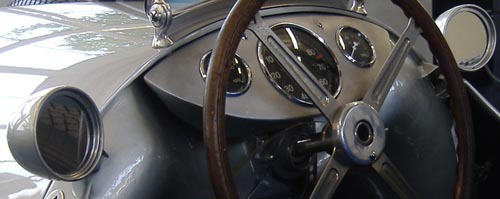
Chasing Down the Dust Bunnies of Automobile Racing History – non semper ea sunt quae videntur – Phaedrus
“Pity the poor Historian!” – Denis Jenkinson | Research is endlessly seductive, writing is hard work. – Barbara Tuchman
Further Observations & Thoughts Regarding the Dust Bunnies of Automobile Racing History
I happened upon the following two photographs entirely by accident. I was in the process of looking for further information on the Vanderbilt Cup and Grand Prize of the Automobile Club of America events held north Milwaukee in 1912 on a road course laid out just to the northeast of the City of Wauwatosa.
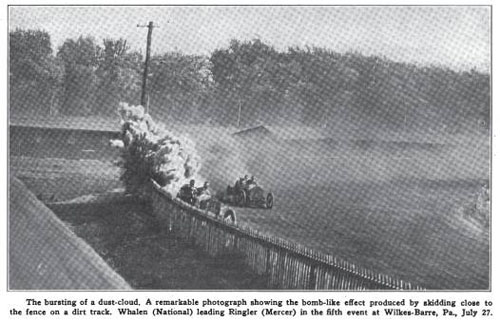 1
1
These were certain to catch my attention because these sorts of events tend to be ignored for the road races of the day by latter-day automotive historians. It is rare to see a photograph such as the one of Whalen riding the “cushion” right up by the fencing. A century later it is still a very remarkable photograph.
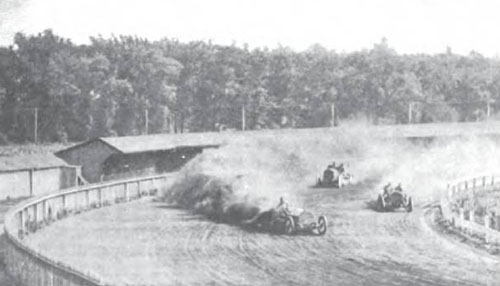 2
2
This is John De Palma in the act of “skidding” through a turn at the Wilkes-Barre Driving Track in the same race meeting as the one above. If nothing else, it should provide an excellent illustration of the dust problem on these sorts of tracks.
Empathy, Anachronistic Thinking, and the Automotive Historian's Burden
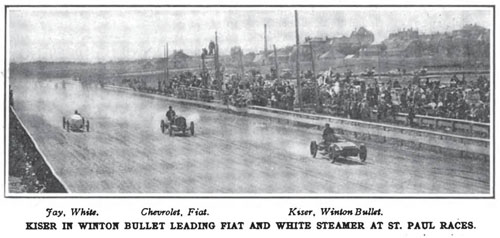 2
2
Out of a combination of curiosity, tedium, and being in a bit of a quandary regarding something I was working on at the moment, I decided to shift my attention away from the issue at hand and visit a few of the internet fora that attempt to address and/or discuss the history of automotive competition. In this case, I tuned into a forum that I visit perhaps three or four times a year. That three or four annual visits to this particular forum is, perhaps, two or three more than truly necessary given that it has scarcely deviated an iota from its focus which is far more aligned with the issues regarding “historic racing” than “motorsports history.” To say that it is definitely not my cup of tea would be an understatement.
I did stumble upon a question being asked in a thread that contained the germ for both a comment on my part that reflected my rather snarky frame of mind at the moment and the food for further thought. My comment did draw a response from an administrator – using a nom de forum, of course – for the site questioning just why, in view of my comment, did I bother to visit the site in the first place. Good question and one to which I did not respond given that it was, first, wasting both his time and mine since I had already long lost any interest in the forum, and, second, I did not think that he would grasp any points that might have been raised regarding the difference between being a discussion forum and actually discussing history.
What did linger was a statement by a typically anonymous participant who asked a question regarding the 1923 Grand Prix de Endurance at Le Mans who, upon being provided an answer by one of the few – if only person – on the forum capable of doing so, wrote in words to the effect that one cannot use modern automobile racing as a basis to understand the past of automobile racing: “You just can not understand the 20's – 30's racing using the terms of modern racing.”4 A true blinding flash of the obvious, but one which continues to elude so many who continue to think that an internet discussion forum entitled with words such as “motorsport” and “history” actually deals with the history of automobile/motor racing.
To extend this perception of not being able to understand automobile racing of the Twenties and Thirties in terms of modern racing, consider the level of incomprehension that is bound to frustrate someone familiar only with the motor racing of recent decades when attempting to make sense of the automobile racing from over a century ago, during the first decade of the Twentieth Century.
Given the rather loose way we define what an “automotive historian” is in the first place – which is not in and of itself a bad thing at all in light of the broad nature of the subject matter in the first place, as well as the manner in the topic is approached, it is not much of a surprise that an internet forum assuming to be devoted to motor racing history tends to be tilting at times towards trivia other times toward nostalgia and, on occasion, towards history derived from research. Nor has it been a surprise that the focus tends towards the low-hanging fruit such as the racing machinery, the cars and their engines, and the statistics and data. After all, one must begin from somewhere and move from that point. However, it could be suggested many do not seem to move very far from that point. Not the kindest thing to write, but an observation based upon what is now a fair number years spent observing these fora.
If we accept the idea that an automotive historian is “made” and not born as such, then what?
This notion, of course, leads us to the issues of historical empathy and its antithesis, anachronistic thinking.
As the Cambridge don Mary Beard tartly observes, the accusation of anachronistic thinking is often as much a ploy as a legitimate criticism: “It is, of course, a general rule that historians accuse each other of making anachronistic value judgments only when they do not share the judgment concerned.”5 So, is it some trepidation that one journeys down that path.
Let us, therefore, define our terms. Empathy: (1) the imaginative projection of a subjective state into an object so that the object appears to be infused with it; (2) the action of understanding, being aware of, being sensitive to, and vicariously experiencing the feelings, thoughts, and experience of another of either the past or present without having the feelings, thoughts, and experience fully communicated in an objectively explicit manner; also : the capacity for this.
Empathy is a relatively recent word, entering usage around 1850. It is derived from the Greek empatheia, literally, passion from empathes, emotional, and from em- + pathos, feelings, emotion.6 By tacking on “historical” in front of empathy, we then suggest the ability of a historian to place him or herself – to the extent that this is possible into the frame(s) of reference of someone (or even a group) from another era. Naturally, this is infinitely easier in theory than in practice, but the essential notion is that historian attempt to the best of his or her ability to view the world as someone might have in the past.
Yet, this is not to suggest that the historian weigh anchor from the present and give him or herself over the vicissitudes of the past, abandoning the present. After all, the historian does know the outcome of most of the various events that were initiated in the past. What is important to keep in mind is that the historian strives to have an understanding of the forces and the Zeitgeist to the extent that the interpretation of those events is based upon an awareness of the contemporary forces and factors that led to those outcomes. That is, attempting to determine the “why” of an event in relation to the “what” and the “how” as well as the “who,” “when,” and the “where.” Once again, easy to theorize about, but devilish to tackle in practice.
When brings us to the issue of the anachronism. This is defined as: (1): an error in chronology; especially: a chronological misplacing of persons, events, objects, or customs in regard to each other; (2): a person or a thing that is chronologically out of place; especially: one from a former age that is incongruous in the present; (3): the state or condition of being chronologically out of place.7
Once more, we circle back to the tricky notion of how one approaches the past and then considers it. Even the very notion of the past that seems to resonate the loudest with many historians is taken from a novel – “The past is a foreign country: they do things differently there.”8 – rather than being the musing of some esteemed scholar reflecting upon the nature of the challenging relationship between the past and history.
Let us take a moment and regard the photograph at the beginning of this essay.
What does one see when looking at the photograph?
The photograph was taken at the site of the Minnesota State Fair Grounds, located in the suburbs of St. Paul in the Hamline district. This was the first automobile race on the track, held on Saturday 8 July and Monday 10 July – along with almost every other form of sports, automobile racing rarely took place on a Sunday at this time.
As was common, the fairgrounds at Hamline had a track for horse racing, a feature of many state fairs. The track at Hamline was a typical one mile track of the day, dirt, of course, and virtually no banking in the corners. The race report in The Automobile stated, “The corners are too sharp and the outside portion of the track is insufficiently elevated.”
The photograph was most likely taken during one of the heats for the Open Race, which was worth $2,500 to the winner. We can make this assumption given that the only events that all of these participated in together were the heats for the open event. Note the dust being raised by the cars as they pass the grandstand to their left.
The three racing machines in the photograph are, from left to right: the White steam-powered racing car known as “Whistling Billy” driven by Webb Jay; the F.I.A.T. owned by Major C.J.S. Miller and driven by Louis Chevrolet; and, the Winton “Bullet” driven by Earl Kiser. It is also interesting to note that each driver is unaccompanied by a riding mechanician.
Although “Whistling Billy” resembles a soap box derby racer of not a vintage not far removed from that of today, the Fiat and the Winton “Bullet” bear little resemble to any of the cars raced within the past few decades. In other words, they look as if they are exactly what they are: cars from over a century ago.
The dust raised by the cars is certainly an oddity for those not familiar with the problems of early automobile racing. Relatively few roads were paved even within the urban areas of the United States and virtually none in the rural areas of the country.
When you begin to pay attention to the details of the photograph, those items away from the action on the track, you can begin to develop a sense of place, some notion of the life and times of those living there. Or at least in that place at that moment.
Then again, what does one not see when looking at the photograph?
In an essay on Errol Morris9 that appeared on his blog, Observations on Film Art, David Bordwell mentioned a remark made to Morris by a soldier who was involved with the scandal at the Abu Ghraib prison during the making of SOP: Standard Operating Procedure: “When you see a picture, you never see what’s outside the frame.”
It is this thought that should lead us to the burden of the historian, since her or she should be able to see what is outside the frame. It is this sense of place, historical empathy if you will, that separates the historian from the Merely Curious and Inquisitive. It is the development and refinement of this “historical empathy” that often leads the Merely Curious and Inquisitive to trod the path to being a historian.
If wie es wirklich war – “to tell it as it really was” would seem to be a reasonable translation – is the basis for the purpose of the modern historian, then more often than not we automotive historians tend to fall far short of that goal. Why that is, of course, seems to be a good question without a good, simple answer for the most part.
When one begins to consider the many observations that could be made from what is in the photograph as well as outside the frame of the photograph, one begins to sense that there might be a circular argument taking place, with historical empathy, anachronistic thinking, and wie es wirklich war all colliding and then collapsing into a big heap of conceptual twaddle.
Which then leads us back to the enduring problem of the historian and those who are not quite at the Merely Curious and Inquisitive stage, yet armed with the fruits of their labors found using Internet search engines and the power of the Wiki so that they tend to think that the historian is largely superfluous at best and an impediment at worst. Once more we face the challenge of understanding the difference between “information” and “knowledge,” with historical empathy being the result of having knowledge with anachronistic thinking more often than not – note the hedge – being the result of having information without having knowledge. Once more we encounter a possible demarcation point in how one approaches, considers, regards, mulls over, or thinks about the photograph, both what can be seen and what lies outside the frame.
Does it really matter whether or not those with little to no interest in thinking or discussing the photograph using the terms of reference of a scholarly historian engage in anachronistic thinking when discussing the photograph from Hamlin in 1905 or similar photographs? While it is probably a certainty that the tides will not cease their daily ebb and flow, or the birds cease to sing, or that the Sun will suddenly darken and wither away, or other such dire happenings occur, it does lead us to think that the challenges of the automotive historian concentrating on automobile racing will only continue.
Should we expect someone completely unfamiliar with the early years of automobile racing to look the Hamlin photograph and not see it from an anachronistic viewpoint? If all one knows is the current motor racing scene, with almost no knowledge of the sport beyond the past several seasons, how can one be expected to not view the photograph from their own, personal frame of reference? To someone such as this, the past is indeed a very foreign country where things are done very differently. Then again, why would such a person even give the photograph a second look?
One path that might come into being in the near future is that the special interest group for the study of the history of automobile racing that has been a long time in development by the Society of Automotive Historians will literally become the forum for the discussion of these sorts of questions and issues. One continues to be aware of the often not so latent resentment found among some who enjoy the past of automobile racing, but not very fond of historians and their ways, especially given that the former are often driven by market forces and the latter by those esoteric reasons that drive people to seek knowledge and share it, perhaps less from altruistic reasons than the notion that historians tend to seek to share their knowledge rather than to deny it to others.
Like it or not, the burden almost always falls to the historian to justify his or her existence and observations rather than the non-historian.
Alas, such is life it would seem.10
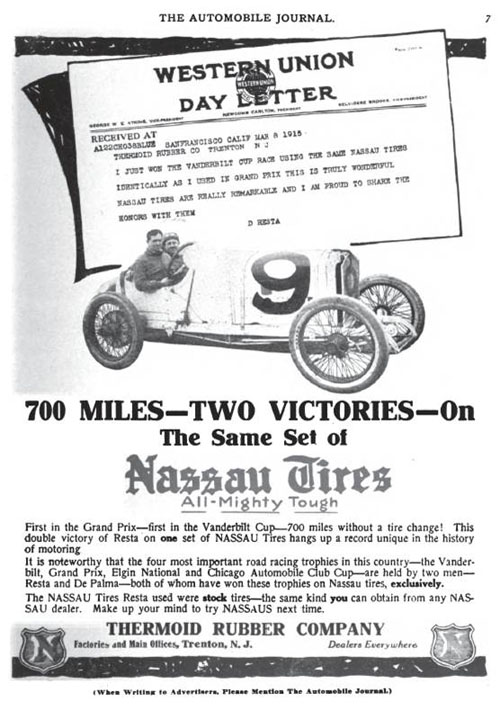 11
11
Turtles Holding Up the World: the Black Books and the Black Books Revised
The “Black Books” have been a part of the scene for what is now a quarter of a century. Formally known as A Record of Grand Prix and Voiturette Racing, the volumes now number fifteen, spanning from the years beginning with 1900 up to the very recent past, 2008. Created by the Formula One Register, the “Black Books” are the turtles upon whose backs the modern mania for information regarding Grand Prix and Formula 1 rests.
The Formula One Register was formed in 1966 by Duncan Rabagliati, Paul Sheldon, and John Thompson. As Sheldon takes a bit of glee in pointing out, it is a source of mild irritation to Bernie Ecclestone that the Formula One Register is beyond his reach. Others have since joined in to help with the research for the books or assisted the FOR in their endeavors. Along with Rabagliati and Sheldon, Richard Page and Robert Barker now form the FOR. Sheldon is the scribe of the organization and has been person largely responsible for getting the books published.
The first volume of A Record of Grand Prix and Voiturette Racing published in 1987 was actually “Volume 6: 1954-1959,” released upon a largely unsuspecting world. It would be difficult for most today to fathom the impact that volume (and subsequent volumes) had upon those attempting to gather information on Grand Prix events back in that day.
It should mentioned that the first foray of the Formula One Register into the world of print came with the publication of The Formula One Record Book12 in 1974. It covered the 1961 through 1965 seasons with a thoroughness that left many of us gasping for air and, frankly, green with envy. It was a revelation and would be followed in Baker’s Dozen years with the first of the “Black Books.” Sheldon followed this with the invaluable Milestones Behind the Marques13 in 1976 – which had a foreword by the inestimable Denis Jenkinson, no less. Sheldon covered the “milestones” of ten marques of the three-litre formula, allowing the reader to have more information than ever when it came to chassis numbers.
Although the information covering Grand Prix events became more and more detailed and exhaustive from the Fifties onward thanks to publications such as Autocourse, Autosport, and so on, few owned or had access to these resources, especially those living somewhat off the beaten path of the Grand Prix world. Simply having a complete entry – with the numbers for the cars, to include the drivers, the entrants, and the chassis and engine combination along with the finishing order was often a true challenge. Starting grids, practice session times, fastest laps other than the best time in the race, and other such relative minutiae could be daunting to find.
Then along came the whole type and chassis number mania. It was no longer enough to simply have Jack Brabham driving a Cooper powered by a Climax engine in the 1959 Italian Grand Prix. It was now Jack Brabham driving number 12, a Cooper Type 45 chassis number ‘F2/23/58’ powered by a Coventry Climax Type FPF engine, entered by the Cooper Car Company. Needless to say, the bar was now raised rather high.
Keep in mind that many of us had no idea what the Type numbers were for Cooper at that time, although we generally could find them for most of the other marques. What was later revealed to be the ‘Type 45’ was, at best, known to some of us as the ‘Mark III’ – with scarcely a clue as to what the chassis numbers were in use for the various races.
While many of us managed to have relatively few holes in our lovingly kept worksheets for each Grand Prix event from about the late Sixties onward, the further back one went, the more blank space appeared on those worksheets. Nor were the events outside the World Championship, which we now knew to be the Championnat du Monde des Conducteurs, covered very well at any point along the way, especially in comparison with those events in the championship.
An oddity that the Formula One Register used in the “Black Books” – one that would actually turn out to be useful later on, was to present all the race information using the contemporary – that is mid-Eighties – format for classifying the finishing order. This meant that the results reflected the way they would have been presented in 1987 rather than, say, 1954. Needless to say, this meant that anachronistic results abounded in the earlier volumes. Picking the Gran Premio di Siracusa of April 1954 at random as being the first instance in the original “Volume 6” where one finds the use of the anachronism “non classified,” with Onofre Marimon and Robert Manzon listed as being “not classified,” a category that did not exist at that moment; they are listed as fifth and sixth, in that order, although Marimon did not finish due to crashing after suffering clutch problems. In the revised “Volume 6,” this is corrected, with Manzon being placed as fifth and Marimon as a retirement.
Another interesting decision of the FOR was to strip the entrants of any commercial connections. This means that one can search in vain for any mention of the “United Dominion Trust – Laystall” entries or those entries of the “Bowmaker Racing Team” – to say nothing of the absence of the “Gold Leaf Team Lotus” entries and so forth. This – to me at least – curious omission is not corrected in the recent revisions. It is interesting to note that this was not the case with the book that appeared in 1974.
Given that my interest in Grand Prix and Formula 1 basically petered out after the 1984 season, my personal collection of the “Black Books” extends only to “Volume 11: 1979-1984.” I do have, in addition, a number of the “Fact Books” that the FOR published over the years, one of the best being the one for the 1966 season, covering not only the Grand Prix and Formula 2 events, per usual, but also the Formula 3 events, the Tasman races, and the United States Auto Club National Championship Trail events.
In addition to “Volume 6” being revised, “Volume 5: 1950-1953” and “Volume 7: 1960-1964” have also been revised in recent days. Errors have been corrected, information updated to better reflect recent research in the seasons being covered. However, as mentioned, there are still a smattering of erroneous entrants as carried on the contemporary entry lists. I still find this quite a curiosity. Although I can understand their personal qualms about such things, the historian in me dismisses such thoughts given that my role as historian is attempt to record as accurately as possible the contemporary scene and then later in any interpretations address such issues, not to arbitrarily omit or dismiss such things from the record. Then again, the members of the FOR do not claim to be historians and do what they for the love of, well, doing what they do.
As mentioned earlier, the results in the “Black Books” reflected contemporary practice for circa 1987 and not what was used at the time for the older events being covered. When the Internet was thrust upon us with a proliferation of sites showering us with great gobs of information and precious little knowledge in most cases, the “Black Books” were pilfered for the information that sprang like kudzu all over the Web. It was very easy to determine where they got their information: the anachronistic results were a dead give away time after time. Naturally, any attribution to the source is missing.
Whatever nitpicking I may have about several of the policies that the Formula One Register may have adopted for the “Black Book” in no way diminishes my respect and admiration of the work that they have accomplished. I include Betty Sheldon in that listing, especially given her wonderful research into the 1933 Gran Premio di Tripoli, ably following up the suggestion of the late Bill Boddy that things might quite be what some would seem them to be based upon what Alfred Neubauer wrote. Her article on the race opened the door for me – and others – to finally get to the bottom of things, which she had already mapped out for us.
Some Book Reviews: a Few Personal Thoughts & Views upon the Written Word…
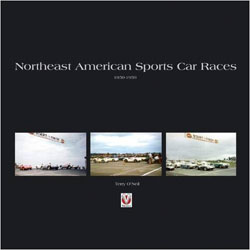

Terry O’Neil, Northeast American Sports Car Races: 1950-1959, Veloce Publishing, 2010, ISBN: 978-1-845842-54-2.
Willem Oosthoek, Sports Car Racing in the South: Texas to Florida 1957-1958, Dalton Watson, 2011, ISBN 978-185443246-9.
Two somewhat different and yet similar approaches to the same general topic, American sports car racing in the Fifties, yet one finds both valuable additions to the bookshelf. To be sure, not everyone will find these tomes to be their cup of tea; yet, others will be attracted to only some aspects of the books – the “data miners” – meaning that they miss the true value of both works.
And, one might readily ask, given the not insignificant sums necessary to acquire these volumes, is that value?
These books attempt to provide windows into the past, offering those with an interest in this past anchor points for their research. Indeed, if there is a word that best describes each effort it is the word “research.” Sports car racing in the United States during the post-World War II era originated in the Northeast, the small village of Watkins Glen in particular. By the early Fifties, sports car racing was beginning to expand and spread throughout the rest of the nation, but while the racing scene expanded to other areas, especially the West Coast, as the tempo picked up, the Northeast scene remained a busy one.
Although one could be satiated simply by looking at the photographs, the circuit maps, and the results, what O’Neil writes about the sport of road racing in the region is both knowledgeable and full of these little nuggets that help one connect the dots – as O’Neil obviously did – and provide food for thought about various aspects of the amateur sports car racing scene.
The tables of races results that O’Neil packs into the book deserve a few words of their own. In an age where “data-mining” for racing statistics in an end in and of itself for many, one can see where O’Neil could have simply provided the results and let it go at that. What O’Neil has done is attempt to provide as complete a set of results as possible for each racing meeting that took place in the Northeast during this period. That along would have been a daunting task. While compiling such a level of information is simply not achievable given the paucity of records of the day was well as rather haphazard recordkeeping, O’Neil has done an amazing job with finding information on the entries and results for the events. It is far more complete and thorough a set of results than one imagined possible.
If O’Neil has done a commendation job of connecting the dots and giving us an excellent chronicle of sports car racing in the American Northeast, it is almost beyond words what Oosthoek has accomplished. If there was ever a deep, black hole of American sports car racing, it is what took place in the South. Oosthoek defines the “South” as not only the traditional “Deep South” of the Southeast – the South Atlantic states, but also the Southwest, states such as Texas, Oklahoma, and even New Mexico.
The slate that Oosthoek began to work with was almost completely clean, the problem not only being the near nonexistent media coverage of such events, but given that they were amateur events and that the race meetings were conducted by amateur organizations often operating on the proverbial shoestring, that Oosthoek even managed a fraction of what he has would be deemed a miracle, so, as mentioned, words fail to provide the magnitude of his feat. I am honest enough to state that I am not sure that I could have managed even half of what he has given us in this volume.
So, just what has Oosthoek given us?
Reading the pages covering the 1957 season alone is to evoke an era, one not long gone, but almost completely forgotten in some cases. The “Little Sebring” race meeting in January, a Regional event of the Sports Car Club of America, was just one of many events from that season new to me. That someone might not be aware of a regional event in what was, frankly, a remote region is scarcely a revelation. What was surprising was to discover that there was as much sports car racing activity in the South as there was at the time.
When Oosthoek began his quest, it would be an understatement to state that I was, for lack of a better word, flabbergasted – if not dumbstruck. While this was a topic that had long intrigued me, my limited research into the subject convinced me that sports car racing in the Southeast – the area I was particularly interested in – during the Fifties and well into the Sixties was pretty much a Black Hole, as close to an historical neutron star was I could imagine. Any effort to do this era justice would face challenges that the word “daunting” would not even come close to being accurate. Needless to say, I stuck this notion for a project in the “I Might Someday Think About Getting Around To It” box.
The 1957 events held at Chester (26-27 April) and Walterboro (May 11-12), South Carolina easily demonstrate just how difficult this task was for Oosthoek: the only mention of the race is in conjunction with another event which states that Lonnie Rix won five awards at the Chester event. As for Walterboro, there is a photograph of Lonnie Rix in his AC Bristol battling with Ed Rahal driving a Jaguar XK-120 Fixed Head Coupe and the trophy Rix won for coming in first overall. Other than that, virtually nothing.
There is an amusing bit of geographical displacement in the book: Oosthoek has the “1st Sunshine Festival Sports Car Races” held on 15-16 June 1957, being run at St. Simons Island, South Carolina – which is rather a surprise to those living in Georgia where the race actually took place. This, it should be noted, was just about the only obvious typo or other such glitch I found in this fine book.
What is interesting is that despite the utter paucity of material that Oosthoek somehow manages to find photographs and something to write about regarding each of the 1957 events. That is, not to mince words, quite an impressive feat of research and dogged determination.
When looking at simply the photographs for the two seasons covered in this volume – other volumes will be following, one is struck by not just the variety of the racing machinery in use, but that some of those cars are quite potent racing cars. The number of different Ferrari and Maserati cars alone was something of a surprise. While one has something of a mental picture of the cars from the usual mixed bag that comprised SCCA races about anywhere in the country, to see some of the cars competing in this, well, backwater of sports car racing is fascinating.
I have thoroughly enjoyed this book and look forward to rest of the volumes. Likewise, I spent many an hour poring through the O’Neil book as well and am very happy it is a part of my research library.14
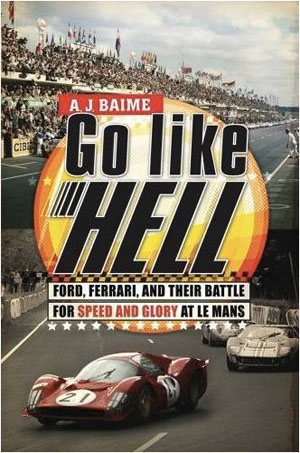
A.J. Baime, Go Like Hell: Ford, Ferrari, and Their Battle for Speed and Glory at Le Mans, Houghton Mifflin Harcourt, 2009, ISBN: 978-0-618-82219-5.
I am still not sure as to exactly why I bought this book.
It was due in large part, of course, that I was passing through an airport and looking for something to read. That I had nary a clue regarding just who “A.J. Baime” was made me very cautious when picking up the book. That Baime was identified as an executive editor at Playboy on the inside of the dust cover almost made me put it back on the shelf.
I was also more than somewhat leery of the book due to its cover.
True, it is an old adage that one should judge a book by its cover, but that it has a Ferrari – apparently the 330P3 of Jean Guichet and Lorenzo Bandini – leading the Ford GT Mark II of Ken Miles and Denny Hulme also struck me as somewhat being a somewhat questionable choice of photographs for the cover of a book on this subject.
Why?
I was under the impression that it was the victory was achieved by Ford in 1966, not Ferrari. Of course, having a Ferrari prominently displayed on the cover probably attracted far more somewhat casual readers than having a Ford GT leading a Ferrari somewhere in the murky background. If nothing else, this subtle bit of pandering to the Ferrari mystique – or simply “myth” which is probably more accurate – raised an eyebrow a notch or two.
However, being on the go, finishing the book I was reading much quicker than I anticipated, and now needing some to read, all this left me vulnerable to purchasing the book. While there were other choices, of course, at the airport bookstore, few appealed to me at the moment. Despite whatever reservations I may have had, I was now committed to reading the book.
While I could, with more than enough justification, launch into another screed upon the evils of sports writers and their sticking their noses into things of which they know not squat, I think that I will shift that discussion towards a slightly different azimuth, nudge the discussion just a tad, if you will. If The Limit by Michael Cannell was what should have been a good story but told in a manner somewhat akin to a “made-for-television-movie” from the Seventies – not necessarily a negative criticism in all cases given that several such productions were excellent (Steven Spielberg’s Duel being one such example), but this is certainly not the case with The Limit since it read as if were the novelization of the usual unexceptional “movie-of-the-week” – then what about Go Like Hell?
Indeed, given that this is another of the “good stories” from the era of the Sixties, one that seems to have faded a bit from view, how does Baime handle the story? Putting aside the usual comments that are too often the part and parcel of sports journalism – hyperbole, any drama milked for effect, an emphasis on characterization, a reluctance to let a good story be ruined by too facts, and what is meant to be snappy prose. Of course, one is left with the awkward problem that journalists – including sportswriters, are supposed to be storytellers; that they are supposed to tell stories in such a way that people will read the stories and – hopefully – gain something from them. What that “something” might be is, naturally, open to discussion, but as a minimum one supposes that the reader should not feel that his time reading what was written was wasted. This then sets the threshold for success rather low, but no one said that life was fair. After all, is not holding the attention of the reader even if but for just a few moments the objective of writing regardless of its genre?
What Baime manages – and, give credit where credit is due – along with Michael Cannell and Charles Leerhsen (Blood and Smoke: A True Tale of Mystery, Mayhem, and the Birth of the Indy 500) is to lead readers to stories that they might not otherwise encounter, or at least not be given the attention they might receive in an abbreviated form. While one is often loath to admitting the obvious, especially should one be a plodding sort of historian and researcher, Baime does tell his story in such a way as to allow one to begin to understand why it is often a challenge to sort out the act of sports-writing from that of writing about sports. They are quite different propositions and yet those differences can be very difficult to articulate.15
The era of “Total Performance” by the Ford Motor Company witnessed the presence of Ford – along with Mercury as well in some instances – in an almost staggering variety of automotive competitions: stock car racing, rallying, drag racing, touring car racing, grand touring racing in the form of the Shelby Cobra, record-breaking, the Indianapolis and the National Championship Trail, Formula One with its English Ford operation and Cosworth, and sports car racing in the form of the Ford GT project. While Ford did very well in some of these endeavors, it had only fleeting success in some and certainly struggled in others.
If we frame any discussion of the Baime book using the criterion of wie es wirklich war, as we should, then once again give some credit where it is due. While certainly not the sort of depiction of the era that the historian would write, Baime does manage to give the reader an idea of how it was during the years that Ford and Ferrari squared off against each other for victory at Le Mans. That there were strong personalities involved in the struggle within both camps tends to aid a sportswriter such as Baime. This is not to damn with faint praise, but simply recognition that such a story lends itself well to such treatment.
It was, both at the moment and in retrospect, a time of melodramatic developments, something that was both operatic in its sturm und drang antics as well as often being pure soap opera. Above all else, it was actually an engaging drama, the sort of story in which both sides of the contest were scarcely angelic heroes nor hardly diabolical villains. Well, some might make an exception for the latter when considering Enzo Ferrari.
Despite my many reservations about the presentation of the story, Baime does manage to convey some the literal drama of the contest between Ford and Ferrari. That he does so by pulling in people such as Phil Hill, Carroll Shelby, John Surtees, and Ken Miles along with a number of others, so much the better. Indeed, it is often less what Baime writes as how he writes it. He captures much of the racing politics of the affair, which are often dismissed or overlooked by the Purists and Enthusiasts. If anything, this has made me waver in airily dismissing the book.
While not all that enthralled with Go Like Hell, I will say that I do find it the sort of book that I would suggest to someone curious about this era. It is a good introduction to the period, one that would, hopefully, lead to further inquiries, to include reading some of the other materials out there on this subject.
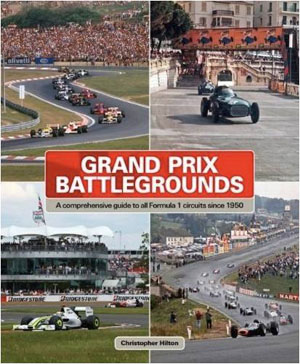
Christopher Hilton, Grand Prix Battlegrounds: A Comprehensive Guide to All Formula 1 Circuits Since 1950, Haynes Publishing, 2010, ISBN: 978-1-84425-694-5.
It might seem a bit pedantic and more than a tad tiresome to begin by pointing out the blindingly obvious that the circuits covered in this book are only those which hosted either a round in the Championnat du Monde des Conducteurs or the FIA Formula 1 World Championship, certainly not all those hosting an event run to the Formule International or Formula 1 since 1950. After all, where are Oulton Park, Albi, Snetterton, Pau, and Siracusa? And, that is to mention simply a very, very few of the circuits that hosted events to the contemporary formula that were outside the championships.
That said, this book by the late Christopher Hilton is certainly one of the best of its type to come along in recent years. The sixty-six venues covered in the book span the years from 1950 season, obviously, until the 2009 season.
The format is simple: a brief sketch of the history of the event; cockpit view – an impression from a driver; eyewitness – the view of someone other than a race official about the circuit; memories and milestones; and, fact of the matter – some statistics regarding the circuit.
In cases where a circuit configuration at a venue changed over the years, Buenos Aires and Silverstone being excellent examples of this, these changes are covered using the same basic linear representation of the circuit. In some instances, the differences between the various configurations can be dramatic, Buenos Aires once again providing a good example of this. Four different layouts – with a slight variation on one of those – were used at what was originally known as the “Autódromo 17 de Octubre” when it was opened in 1952, being renamed in 1955 as the “Autódromo Municipal de la Ciudad de Buenos Aires,” before being once more undergoing a name change as “Autódromo Municipal del Parque Almirante Brown de la Ciudad de Buenos Aires” during the Sixties then become the “Autódromo Oscar Gálvez” after yet another name change. While Hilton does not provide the various name changes, he does provide the circuit diagram showing “Circuito No. 2,” Circuito No. 6,” and “Circuito No. 15,” three of the circuit variations used for the events held as part of the world championship, omitting “Circuito No. 9” for some reason.
Then there are the countries which had a number of different venues host their round in the championship, with France in second place with seven to the nine of the United States. Of course, given that one of the venues for the USA was the Indianapolis Motor Speedway from 1950 to 1960 is something that tends to send the Formula 1 Purists into apoplectic fits, almost swallowing their tongues at such a thing. In addition to the Indianapolis Motor Speedway – Hilton only includes the events from 2000 thru 2007, the United States hosted championship events at Dallas, Detroit, Las Vegas (Caesar’s Palace), Long Beach, Phoenix, Riverside, Sebring, and, of course, Watkins Glen. Of course, the United States Grand Prix was only held at five of the venues, which should be one short according to the Purists, but such quibbles are part of why we historians do so poorly when thrust into the world of the Enthusiast.
It was interesting to note the seven venues that hosted either the Grand Prix de l’Automobile Club de France or the Grand Prix de France – which are not quite the same thing, I am afraid, although it is another one of those things the Formula 1 Purists and Enthusiasts fume about whenever it gets mentioned. The French venues: Le Mans-Bugatti, Clermont-Ferrand, Dijon-Prenois (which also managed to host the “Swiss Grand Prix,” which was justifiably seen as a sign of the Apocalypse), Magny-Cours, Paul Ricard, Reims-Gueux, and Rouen-les-Essarts. It always struck me as both rather fitting and yet rather sad that the initial and final runnings of the Grand Prix de l’Automobile Club de France took place in the Le Mans area, especially given the wretched “Bugatti Circuit” that was used in 1967 for the final race in this great series. This is not, however mentioned by Hilton.
One of the earliest such books appeared in 1968, being entitled Grand Prix Championship Courses and Drivers,16 and was written by Griffith “Griff” Borgeson. Taking the Borgeson book down from the shelf and then comparing it was the Hilton book was ample demonstration as to how much the world can change in four decades.

Anthony Pritchard, Silver Arrows In Camera: A Photographic Portrait of the Mercedes-Benz and Auto Union Grand Prix Teams 1934-39, Haynes Publishing, 2008, ISBN: 978-1-84425-467-5.
The “Prolific Pritchard” – as I tend to think of Anthony Pritchard, produced a book filled with what can only be truly regarded as “eye candy” for those interested in that era of Thirties racing dominated by the German teams. It is, it should be clearly stated up front, yet another of those books that costs a ton, but certainly finds a place on the bookshelf for the photographs alone, if not necessarily the text.
The format is simple and straightforward, Pritchard providing an overview of the seasons prior to 1934 and the German involvement in Grand Prix racing, a look at the formula itself and the cars developed for it, then a look at each season from 1934 to 1939, starting with a potted review of each season followed by race-by-race coverage of the season. In the final chapters, Pritchard covers record-breaking, hill-climbing, and the drivers for both Auto-Union and Daimler-Benz, along with a post-war aftermath.
As seems to be case with most writing on this era, not much discussion on how the formulae for the 1934-1937 and 1938-1939 seasons came to be, nor a breakdown for the sliding weight-displacement scale for the latter two seasons. It is interesting to note this remark regarding the paint-scraping myth that Neubauer wrote about: “In 2007 DaimlerChrysler held a symposium to investigate why the colour of the W25s was changed from white to silver, but no definite conclusion was reached.”17
Given that I was a participant at the symposium being referred to, the focus was on the validity of the paint-scraping tale as told by Neubauer with the question of the change from white to silver being very much a secondary consideration. I have read on far too many occasions that no conclusion was reached regarding this tale. Being the rather simple-minded soul that I am, in my opinion the evidence presented at the symposium was overwhelmingly in support of the W25 machines being white from the very start, long before the Eifelrennen in June. This meaning, of course, that the Neubauer tale was simply not credible. I will not attempt to beat any more glue out of this dead horse, but it did not exactly make the Pritchard book much more than a “picture book” after reading that. Not to be too harsh on poor Anthony Pritchard, but a book being sold for $150 should be more careful regarding such things.
In the first appendix, entitled “Silver Arrows Survivors,” the 1939 Mercedes cars are given as being the Typ “W163” machines, while in the specifications for the cars given in next appendix correctly refers to the 1938-1939 machines as the “W154” – did anyone notice this disconnect?
I would wade into the issue regarding the designations of the Auto-Union machines, but that is another one of those “Liberty Valance” situations where the legend has replaced the truth. Besides, it is always something of an advantage to be somewhat out of step with everyone else, one of those things that gives one a small measure of, well, satisfaction and even a certain smugness. Sins of the first degree, of course, but I will somehow manage such a burden.
For what little it might be worth, here is what the Auto-Union cars were actually known in the days that they were on the track: the “Type A” was the Typ 1934; the “Type B” was the Typ 1935; the “Type C” was the Typ 1936; and, the “Type D” was the Typ 1938.
All the quibbles aside, as has been stated several times before, the photographs are the heart of the book. It complements the books by Chris Nixon and Karl Ludvigsen and others on this era, but certainly does not replace them.
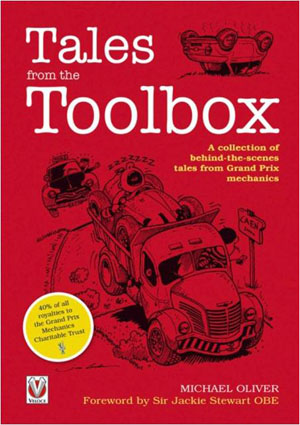
Michael Oliver, Tales from the Toolbox: A Collection of Behind-the-Scenes Tales from Grand Prix Mechanics, Veloce Publishing, 2009, ISBN: 978-1-84584-199-7.
This is a pleasant gem of a book. I must make the declaration up front that I am friends with Michael Oliver and have long admired his work with the Lotus marque, his books on the Lotus 49 and Lotus 72 being exceptional pieces of good research and an amazing dedication to such endeavors. Plus, he is quite a nice fellow and, as this books demonstrates, has a way of finding good stories and bringing them to our attention. Being a nice sort of chap, Oliver is donating forty percent of the royalties from this book to the Mechanics Charitable Trust.
Something else that I must admit is that I have long had a deep admiration for that unsung group of folks, the racing mechanics, regardless of what series they labored to make happen. That Michael Oliver has managed to assemble such a wonderful collection of the tales of that hardy bunch associated with Grand Prix racing is our good fortune. The trials, tribulations, pranks, and panics of this group over the seasons makes for both delightful reading as well as giving those not quite familiar with hot it once was an idea of the Zeitgeist that the mechanics inhabited.
Suffice it to simply write this is one of my favorites, there always being something interesting to read whenever I pick it. I cannot say that about many books, alas, but this is one of them.
American Race Tracks
Crown Point & Lowell / Indiana
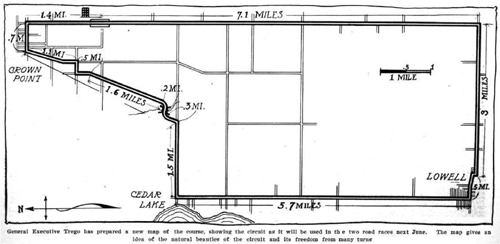 18
18
The first of the Western – or at least Midwestern – road races, the Cobe and Indian Trophy events were promoted by the Chicago Automobile Club. Crown Point was only forty-five from Chicago, due south of Gary.
As laid out, the course measured 23.6 miles with the roadway measuring from only eleven feet in width to eighteen feet at its widest. By the race day the roadway had been improved to the extent that the minimum width was rarely less than fourteen or fifteen feet on the course.
 19
19
This is a photograph taken in April of the road in front of the site where the grandstand would be built, as designated by the “+” on the photograph.
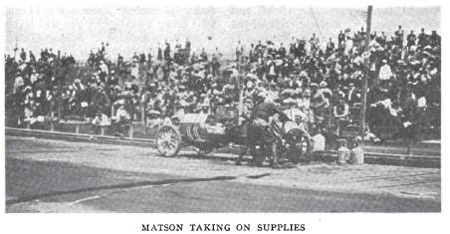 20
20
Here is a photograph of pit action in front of the grandstand.
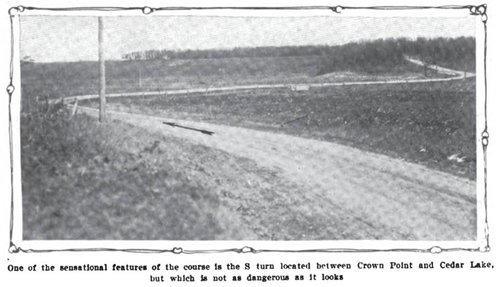 21
21
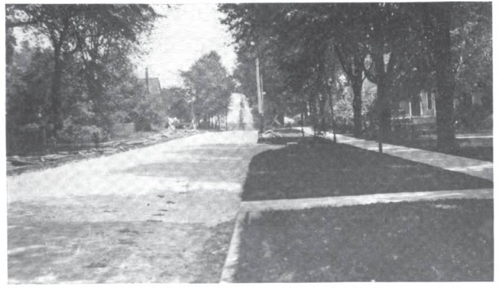 22
22
This is a section of road newly rebuilt for the race.
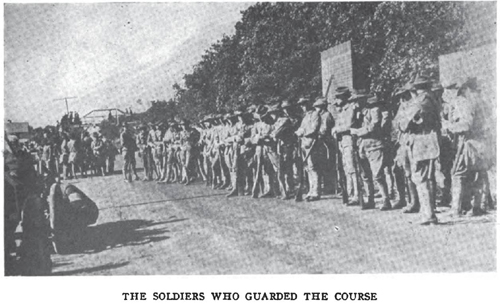 23
23
Lowell / Massachusetts
 24
24
When “road racing fever” hit the United States during the 1908 and 1909 seasons, road races popped up in the most interesting and often unusual places, Lowell perhaps being among both of those. The course was used for only two years, 1908 and 1909. The course ran parallel to the Merrimack River. The distance from the grandstands to the “Hairpin” corner was about four and a half miles, the surface being macadam and “well oiled,” covered with fine gravel. The backstretch was said to contain thirty-five turns and five “S” combinations, not to mention the “Dip of Death.” The “Dip of Death” was so named due to the road literally dropping thirty-seven feet in a distance of about three hundred feet. This being followed by a turn and sharp ascent meant that the “Dip” was usually taken at a very rapid clip, making it much more dramatic than it would seem otherwise. It should be noted that the course was run clockwise.
Here are several views of the Lowell course:
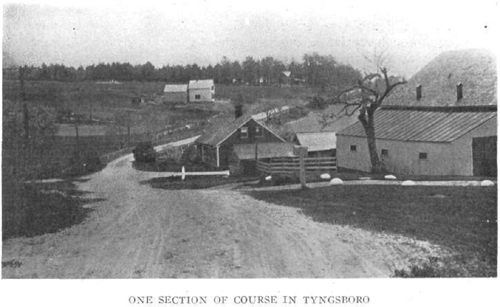 25
25
 26
26
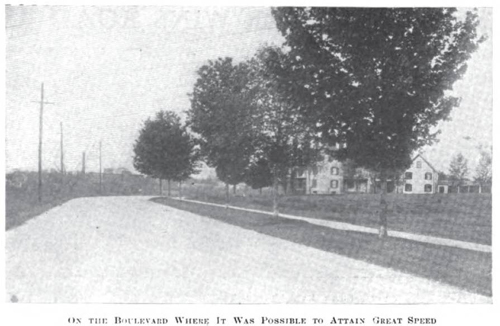 27
27
Fernback Dam, Cincinnati / Ohio
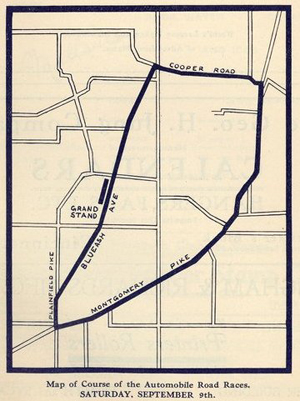 28
28
Held on a road course just to the northeast of Cincinnati, the event was held to celebrate the completion of the Fernback Dam on the Ohio River. The celebration began on Monday, 4 September and ended on Saturday, 9 September with the automobile race. Events held in conjunction with the celebration ranged from then usual plethora of addresses to band contests, swimming, canoeing, boat races. The band contests were held at the Cincinnati Base Ball Park, there being three classes competing, the classes based upon the size of the membership of the band.
The Cincinnati Trophy and the Hamilton Trophy events were run concurrently, the former for nonstock automobiles under 600 cubic inches and the latter for those nonstock cars with engine displacements of under 300 cubic inches. The Cincinnati Trophy was 25 laps, 197.5 miles and the Hamilton Trophy was 19 laps, 150.1 miles. Eddie Hearne won the “Big Car” event at the wheel of a Fiat and Johnny Jenkins won the “Small Car” event driving a Cole.
The course that was laid out was 7.9 miles long. The basic roads that comprised the course are still there, although much of the area scarcely resembles what it looked like in 1911.
Milwaukee – Wauwatosa / Wisconsin
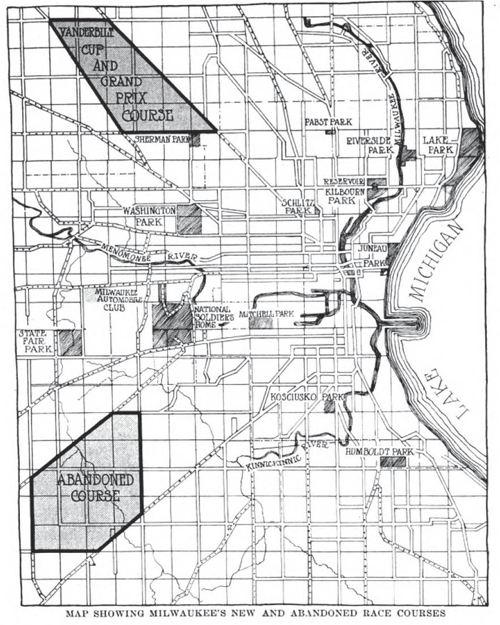 29
29
The road course originally planned to be used for the 1912 William K. Vanderbilt, Jr. Cup and the Grand Prize of the Automobile Club of America events, the Greenfield course, can be seen in the lower left hand corner of the map. The Greenfield course was abandoned after the City of Wauwatosa made a late bid to the promoters of the events, the Milwaukee Automobile Dealers’ Association. The Wauwatosa bid was driven by the fact that after the Greenfield course was selected in the early the Spring, the access rights for the land bordering the course were being obtained by concessionaires and not the M.A.D.A., which meant that it was being denied a major means of funding the event.
The City of Wauwatosa, aware of the situation to the south, quietly survey a possible course and then approached the property owners with land abutting the course for permission to use their property should the bid be accepted. Within two days ninety-eight of the one hundred and one signed the agreement the other three signed by the end of a week. The bid was then submitted and accepted in secret in early June. The agreement was then kept secret until the end of July when the announcement was made regarding the new course for the events.
The original course was surveyed at 8.2 miles, but by the time the course was actually ready for use it was now 7.88 miles in length due to the easing of the corners and some subtle straightening of the two Fond du Lac Roads. The course ran northwest along the old – or North – Fond du Lac Road at the corner of the city limits of Milwaukee to the intersection of Town Line Road where town limits of Wauwatosa and Granville met, west to Sommerville and the intersection with new – or South – Fond du Lac Road, where it then ran southeast to the intersection of Burleigh Road, then turned east to the intersection of Old Fond du Lac Road.
Sherman Park was located on Burleigh Road just prior to the intersection with Old Fond du Lac Road. The two streetcar lines of Milwaukee both terminated at the southern corners of the race course, greatly facilitating transport to the venue. In addition, the main line of the Chicago, Milwaukee, and St. Paul ran only a half mile south of the course.
The proposal to have the entire route paved in concrete never quite came to fruition, although various sections of the course were paved in different materials. The oiling of the course in the days just prior to the events was a matter of great attention, but the weather caused delay.
 30
30
If one looks closely, the course can still be found in the modern day Milwaukee cityscape. The old or North Fond du Lac Road is now West Fond du Lac Road and the new or South Fond du Lac Road is now West Appleton Avenue. Burleigh Road, which had been an extension of Burleigh Street is now the latter. Town Road is now West Hampton Avenue.
Perry Hill and Algonquin Hill / Illinois
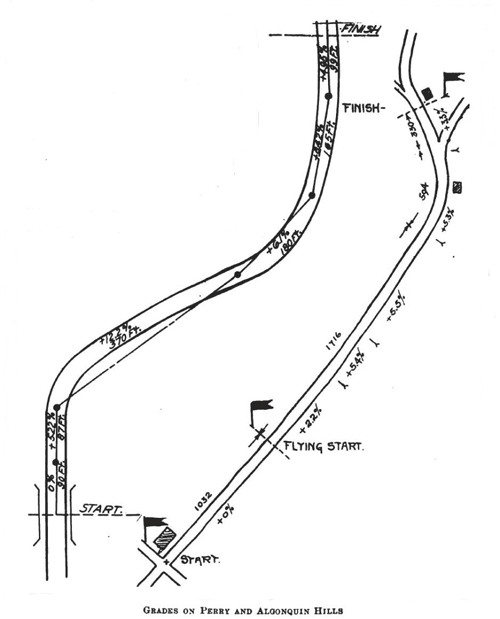 31
31
Along with Giants Despair at Wilkes-Barre, the Algonquin hill climb was among the premier of such events. Promoted by the Chicago Automobile Club, the hill climbs were held from 1906 to 1912. The event scheduled for 1913 was canceled and with the sport of hill climbing already in the wane, it was not rescheduled for the following years.
Perry Hill was approximately one mile south of the village of Algonquin and the other course used, Phillips Hill, near the township of Dundee. After 1909, Phillips Hill was replaced by a purpose-built hill climb course, Algonquin Hill.
Wilbraham Hill, Springfield / Massachusetts32
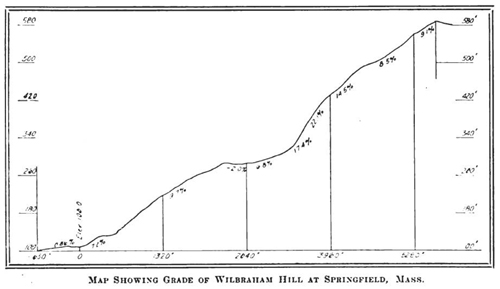 33
33
The Wilbraham Hill venue measured exactly one mile – 5,280 feet, the finish line being just prior to the actual top of the hill itself, which was five hundred and eighty feet above the starting line.
Dead Horse Hill, Worchester / Massachusetts
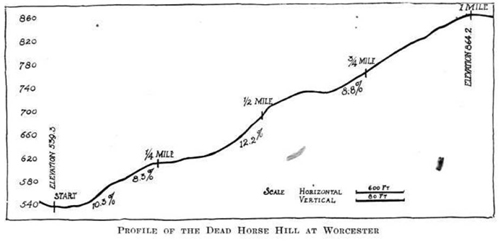 34
34
Another of the popular hill climb venues, Dead Horse Hill was as much social event as automotive contest when run. This was in no small part due to Dead Horse being an amateur event in the truest sense of the word, in the positive sense, that is. Indeed, it could be observed that many of the hill climb contests were events that attracted the amateurs to compete.
Notes
- Automobile Topics, 3 August 1912, p. 751.
- “Amenities of Racing on Half-Mile Tracks,” The Automobile, 1 August 1912, p. 250.
- “Exciting Races at St. Paul Track,” The Automobile, 20 July 1905, Volume XIII No. 3, p. 93.
- For the record, it should be pointed that this occurred in a thread found on the “Motorsport History Fo-rum” at the Ten-Tenths site. It is, in all likelihood, about the only thing remotely worthy of note that I have ever had cause to mention from this site. An unkind remark, yes, but, alas, all too true.
- Mary Beard, “Alexander: How Great?”, New York Review of Books, 27 October 2011.
- Merriam-Webster’s Collegiate Dictionary, Eleventh Edition, Springfield: Merriam-Webster, 2004, p. 408.
- Ibid., p. 43.
- L.P. Hartley, The Go-Between, London: Hamish Hamilton, 1953. David Lowenthal used the Hartley quotation as the title of his muse upon the nature of the past and its relationship with history, The Past is a Foreign Country, Cambridge: Cambridge University Press, 1985.
- “Errol Morris, Boy Detective,” 4 November 2010.
- One would not be remiss to ask why questions and issues such as the preceding are a frequent topic of discussion in Rear View Mirror. It is no small part to the lack of any such discussion elsewhere. At least, any discussion that I am aware of or privy to, that is. It is a common element among Internet discussion fora that the forum itself not be discussed. This is largely due to the moderator or bulletin board/ forum owner not wishing those participating in the discussion forum to use such a discussion topic as a means to attack or focus any attention on the forum itself. This leads to the forum becoming an “unexamined life” and, in too many cases, not worth living. Indeed, a rarity among topics that are discussed on these fora is any discussion as to the very nature of history itself as it pertains to the subject matter at hand. The usual response by a forum moderator to any one bringing up such topics is a warning to keep the discussion germane to the topic, with some also using banishment, temporary or permanent, as means to encourage the others to steer clear of such discussion. And, yes, having these one-sided discussions can be a bit repetitious and they do tend to ramble on and bounce around a bit, before coming to an abrupt halt. However, it is in my nature to puzzle over such questions, to ponder those aspects of this topic area that few would even think about in their wilder moments, much less actually write about. As has been said, it is not an easy mission, but someone has to do it….
- The Automobile Journal, 10 March 1915, Volume XXXIX No. 3, p. 7.
- John Thompson with Duncan Rabagliati and Dr. K. Paul Sheldon, A Record of Grand Prix and Voi-turette Racing, London: Leslie Frewin Publishers, 1974.
- Paul Sheldon, Milestones Behind the Marques, London: David & Charles, 1976.
- It should be noted O’Neil had Bill Green, the historian of the International Motor Racing Research Center write the foreword the book. Both Green and Mark Steigerwald, then the librarian/archivist of the IMRRC before moving on to Cornell University, are singled out for much deserved praise for their help with the book.
- Although William “Bill” Nack is a sportswriter, his book Secretariat (Hyperion, Re-issue 2010) reads as if it were a book written about a sports-related subject rather than a “sports book.” In this sense, Nack’s book is similar to Seabiscuit (Ballantine Books, 2002) by Laura Hillenbrand, with the exception, of course, that she is not a sportswriter. That both books are about the sport of horse racing, somewhat similar in that they focus on a single horse and yet quite different in where and how that focus is handled. That said, both are excellent books, raising about the genre of sports-writing. One begins to quickly sense the problems of how to articulate this issue regarding literary style and content.
- It was published by W.W. Norton & Company of New York.
- Page 53.
- Indiana Offers Natural Road Race Course,” Motor Age, 15 April 1909, Volume XV No. 15, p. 3.
- Ibid., p. 1.
- “Crown Point Races Were Disappointing,” Automobile Topics Illustrated, 26 June 1909, Volume XVIII No. 12, p. 787.
- Motor Age, 15 April 1909, op. cit., p. 2.
- “Big Field Probably in Chicago Road Meet,” Motor Age, 27 May 1909, p. 4.
- Automobile Topics Illustrated, 26 June 1909, op. cit.
- “The Course as Seen From a Racing Car,” The Automobile, 9 September 1909, p. 431.
- “Lowell’s Labor Day Stock Car Race,” Automobile Topics Illustrated, 5 September 1908, Volume XVI No. 22, p. 1487.
- “Lowell Road Race Returns Strang Victor,” Motor Age, 10 September 1908, Volume XIV No. 11, p. 2.
- Ibid., p. 3.
- “Official Program, Fernback Dam Celebration, Auto Road Races, September 4 to 9 [1911],” p. 37.
- “Milwaukee Chooses New Race Circuit,” Motor Age, 1 August 1912, p. 12.
- “Auto Merchants Gather at Milwaukee,” Motor Age, 12 September 1912, p. 5.
- Motor Age, 10 September 1908, Volume XIV No. 11, p. 19.
- Motor Age, 17 September 1908, Volume XIV No. 12, p. 14.
- “Knox Car Fastest on Wilbraham Hill,” Motor Age, 17 September 1908, Volume XIV No. 12, p. 14.
- “Dead Horse Hill Climb Results in a New Record,” Motor Age, 17 June 1909, Volume XV No. 24, p. 7.
